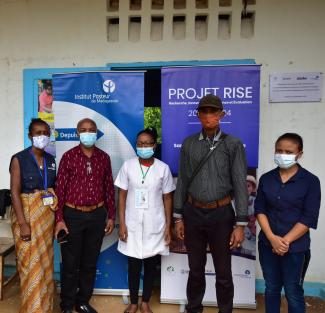Some parts of southeastern Madagascar are considered hotspots for malaria. These ‘redzones’ are places where the spread and risk of severe illness from malaria is high.
The United States Agency for International Development (USAID) through the President's Malaria Initiative (PMI) funds many activities to keep people in Madagascar safe from malaria, including distributing bed nets, spraying homes and public building with insecticide, and providing tests and treatment medication.
USAID also monitors and studies the malaria situation in Madagascar to make sure that the treatments being used remain effective.
Since 2005, Madagascar’s National Malaria Policy has used drugs known as ACTs (or Artemisinin-based Combination Therapies), to treat uncomplicated malaria caused by Plasmodium falciparum, a parasite which is transmitted to humans through a mosquito bite. However, there are signs that Plasmodium falciparum is becoming resistant to some drug treatments, which is a threat to malaria control, especially in children.
A recent study was done in the communities of Vohitromby (district of Farafangana) and Antsenavolo (district of Mananjary) led by Institut Pasteur de Madagascar (IPM) to monitor whether the drugs used to treat malaria there are still effective. The study was done in collaboration with Madagascar’s National Malaria Control Program (NMCP) and was conducted under IPM’s Research, Innovation, Surveillance, and Evaluation (RISE) project funded by USAID.
Ms. Emma is the head of the Vohitromby health center and she believes the treatments her patients received under the study had a positive effect for her patients.
“If IPM would have not been present during the malaria epidemics and for this antimalarial drug study, I really cannot imagine what we would have had to face, knowing that we are part of a red zone when it comes to malaria.”
Ms. Emma helped recruit patients aged between 6 months and 15 years into the study. These participants were people who tested positive for malaria. They received ACT drugs to treat the disease.
Ms. Baotsara is a mother of four children who participated in the study. She is convinced that the treatment they received at Vohitromby’s local health center led to an improvement in their health. [[nid:432701]]
“(This) was greatly beneficial to us. Our children are very healthy and we are thankful,” she says.
The communities of Vohitromby and the Antsenavolo received another significant benefit from the study. Initially, their health centers were not in adequate condition to conduct the study, so IPM and USAID, through the RISE project, refurbished both health centers.
The study was also carried out at two more health centers in Ankazomborona/Marovoay and Matanga/Vangaindrano. At these two centers, the study was led by the NMCP.
The joint efforts between IPM and the NMCP resulted in 770 young patients being recruited into the study across the four health centers.
At present, all of the study’s clinical data are being analyzed.[[nid:432706]]

Photo: Institut Pasteur de Madagascar (IPM)
